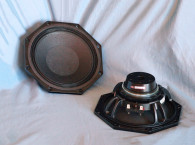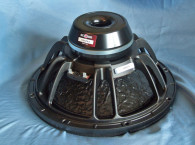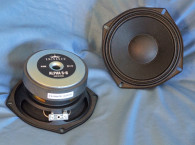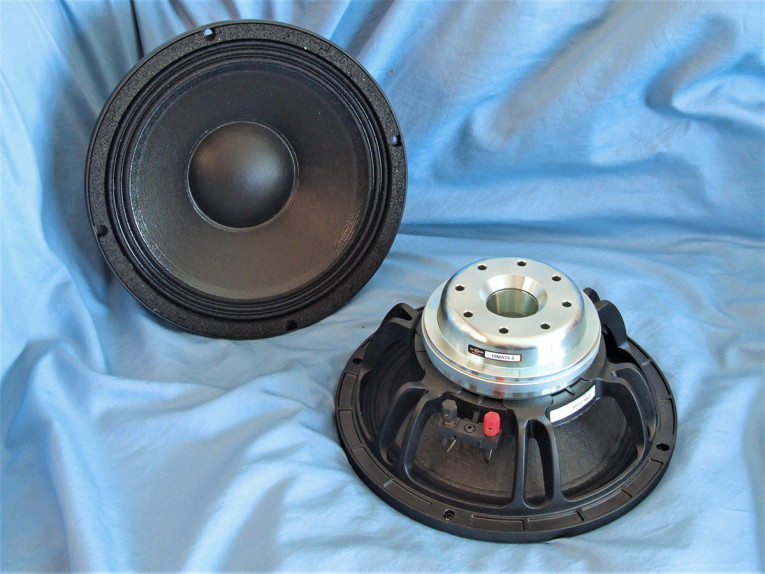
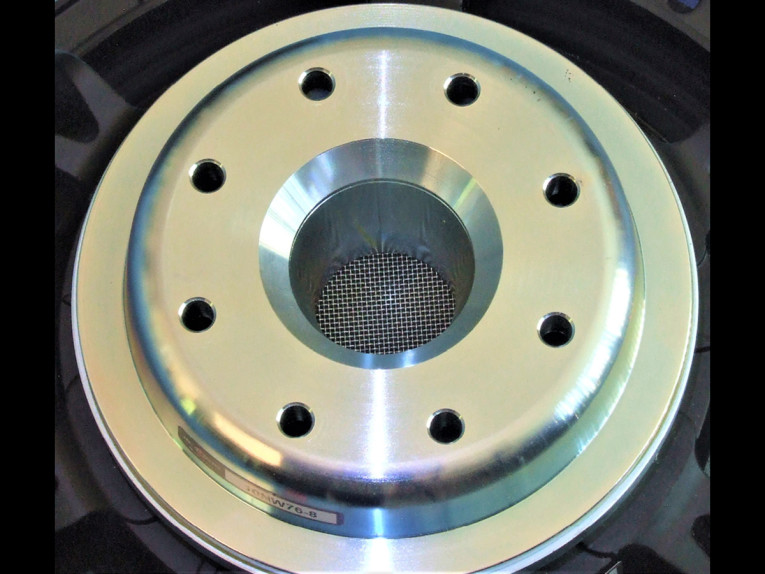
The 10NW76 is a new high power handling 10” driver (Photo 1). Applications for the 10NW76 include use in line arrays, small two-way monitors, and as a subwoofer, or as a midbass driver in multi-way systems. The feature set for the 10NW76 is similar to most high-performance pro sound drivers, fairly substantial. Starting with the frame, the 10NW76 uses a proprietary 12-spoke (six double spokes) cast-aluminum frame incorporating 12 5mm×2mm rectangular vent holes in the area below the spider mounting shelf for enhanced voice coil cooling. This series of cooling vents allows air to move past the voice coil and across the front side of the neodymium motor assembly. Additional cooling is provided in a tapered and flared 1.5” diameter pole vent in conjunction with eight 6.5mm diameter peripheral vents located on the milled back plate (Photo 2).
The cone assembly consists of a curvilinear waterproof coated paper cone along with a 3.5” diameter waterproof coated paper dust cap. Compliance is supplied by pleated coated polycotton cloth three-roll-type surround and from a cloth-type 5.5” diameter flat spider (damper). Details of the B&C Speakers 10NW76 motor design include a neodymium ring magnet structure sandwiched between a 9.8mm polished milled front plate and the polished milled and shaped back plate/return cup. The neodymium magnet motor was FEA-designed using a 76mm (3”) diameter voice coil wound with round copper-clad aluminum wire (CCAW) on a non-conducting glass fiber former.
Considering all the various cooling features and the 3” diameter voice coil, rated power handling is 400W (800W continuous), making the 10NW76 the highest power handling 10” in the B&C Speakers line-up. As with a number of B&C Speakers’ designs, this motor includes an aluminum demodulating ring (shorting ring or Faraday shield). Connection to the 10NW76 is made by a pair of color-coded push terminals located on one side of the frame.
I commenced testing of the 10NW76 using the LinearX LMS analyzer and Physical LAB IMP Box to create both voltage and admittance (current) curves. The driver was clamped to a rigid test fixture in free-air at 0.3V, 1V, 3V, 6V, 10V, 15V, 20V, and 30V allowing the voice coil to progressively heat up between sweeps with a 200Hz sine wave. The B&C Speakers driver remained sufficiently linear enough for LEAP 5 to curve fit at the 30V level.
I no longer use a single added mass measurement and instead use the measured Mmd data (43.7 grams for the 10NW76). The 16 550-point stepped sine wave sweeps for each 10NW76 sample were post-processed and the voltage curves divided by the current curves to generate impedance curves. The phase was derived using the LMS calculation method. I imported the data, along with the accompanying voltage curves, to the LEAP 5 Enclosure Shop software. Because Thiele-Small (T-S) parameters provided by the majority of OEM manufacturers is generated using either the standard model or the LEAP 4 TSL model, I additionally created a LEAP 4 TSL parameter set using the 1V free-air curves.
I selected the complete data set, the multiple voltage impedance curves for the LTD model, and the single 1V impedance curve for the TSL model in the Transducer Model Derivation menu in LEAP 5 and created the parameters for the computer box simulations. Figure 1 shows the 1V free-air impedance curve. Table 1 compares the LEAP 5 LTD and TSL data and factory parameters for both of the B&C Speakers 10NW76 samples.
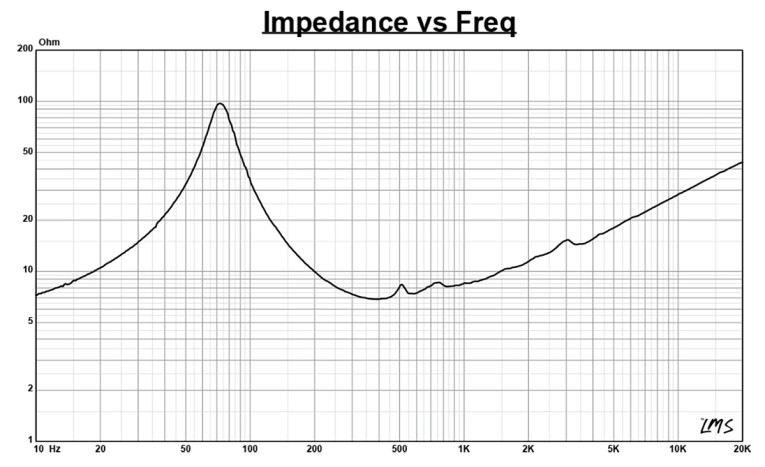
LEAP 5 parameter calculation results for the 10NW76 were fairly close to the B&C Speakers published data for this driver, even considering the more conservative Sd number that B&C Speakers uses (I use the cone diameter plus 50% of the surround), plus a different Xmax methodology. The published coil length and gap height dictate a 4.25mm physical Xmax, while B&C Speakers lists Xmax as 6.8mm is, like a lot of other pro sound manufacturers, specifically accounting for the gap area fringe field, which I understand and have no problem with. It’s roughly equal to the excursion at the 10% distortion level.
Following my established measurement protocol, I configured computer enclosure simulations using the LEAP LTD parameters for Sample 1. Two computer box simulations were programmed into LEAP 5, the first being the recommended vented enclosure volume and tuning from B&C Speakers, which was 0.92ft3 with a 65Hz port tuning. The second simulation was created for a more compact 0.5ft3 enclosure tuned to 85Hz. Both simulations included 15% fiberglass fill material. Figure 2 displays the results for the 10NW76 in the two vented enclosures at 2.83V and at a voltage level sufficiently high enough to increase cone excursion to Xmax + 15% (5.18mm for the 10NW76).
This produced a F3 frequency of 57Hz (F6=54Hz) for factory recommended enclosure and -3dB=78Hz (F6=71Hz) for the more compact vented simulation. Increasing the voltage input to the simulations until the maximum linear cone excursion was reached resulted in 120dB at 63.5V for the factory recommended box and 125dB for at 90V input level for the smaller vented box. Figure 3 shows the 2.83V group delay curves. Figure 4 shows the 63.5V/90V excursion curves. Please note that the drivers start over excursing below about 65Hz, so an appropriate high-pass filter will increase the undistorted output considerably, but all vented enclosures really should have a high-pass filter.
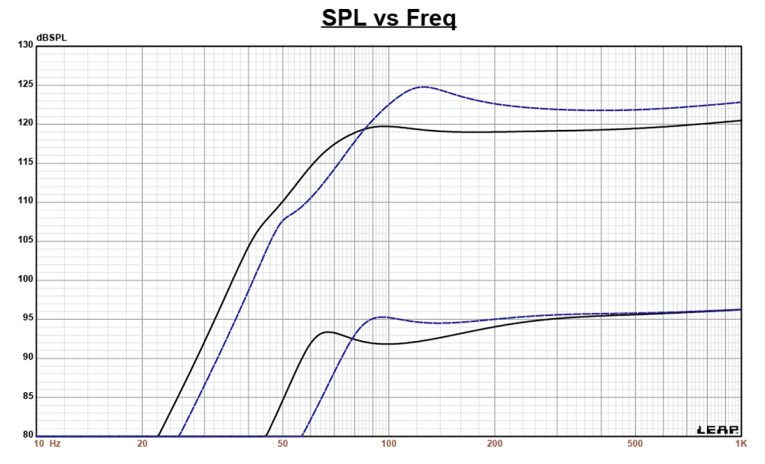


Klippel analysis for the B&C Speakers 10” pro sound woofer produced the Bl(X), Kms(X), and Bl and Kms symmetry range plots shown in Figures 5–8. Our analyzer is provided courtesy of Klippel GmbH and the analysis is performed by Pat Turnmire, owner of Redrock Acoustics and author of the SpeaD and RevSpeaD transducer development software. The Bl(X) curve for the 10NW76 (Figure 5) is moderately broad and symmetrical, typical of a medium Xmax driver, but with small amount of forward (coil-out) offset. Looking at the Bl symmetry plot (Figure 6), this curve shows a 2.2mm coil-in offset at the 2.6mm physical Xmax position. This offset remains relatively constant throughout the operating range of this driver, suggesting this is a deliberate forward offset.
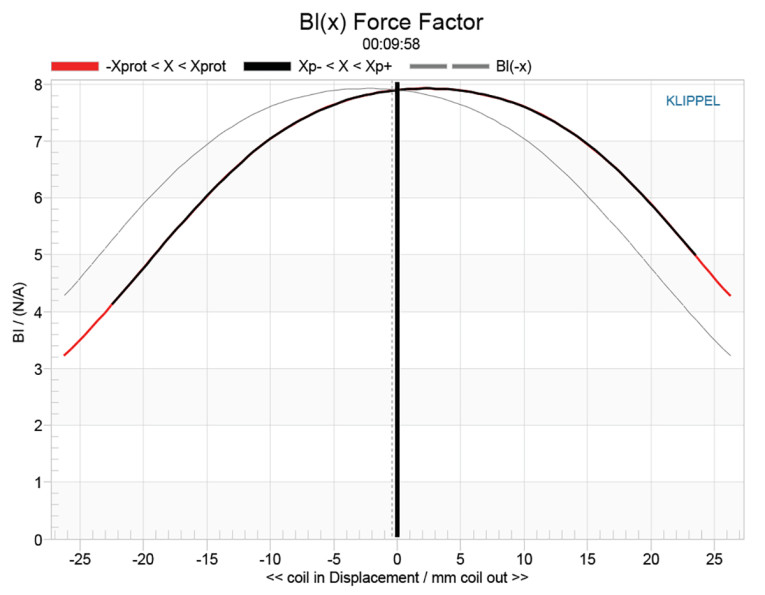

Figure 7 and Figure 8 show the Kms(X) and Kms symmetry range curves. The Kms(X) curve is rather symmetrical in both directions accompanied by a coil-out offset. Looking at the Kms symmetry range plot, the coil-out offset at the 4.25mm physical Xmax of the driver is about the same as the Bl offset, 2.2mm, and remains constant.
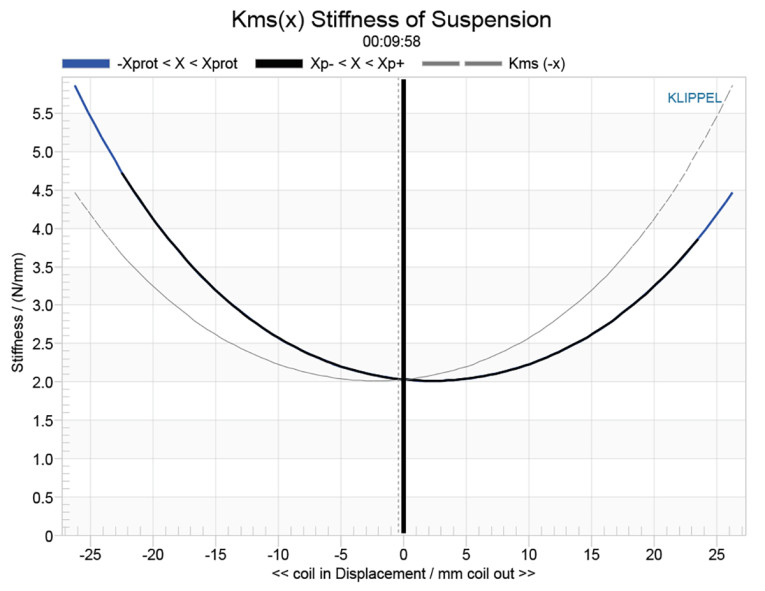
Displacement limiting numbers calculated by the Klippel analyzer for the 10NW76 were XBl @ 82% Bl=13mm and for XC @ 75% Cms was 11.3mm, which means that for this B&C Speakers driver, the compliance is the most limiting factor for prescribed distortion level of 10%, so in a two-way application, quite good. Both numbers are substantially greater than the driver’s physical Xmax.
Figure 9 gives the 10NW76’s inductance curves Le(X). Inductance will typically increase in the rear direction from the zero rest position as the voice coil covers more pole area, which is not what is happening here, but is typical of this type of neodymium motor. The inductance swing for this driver is a really low 0.010 to 0.004mH, which is excellent performance.

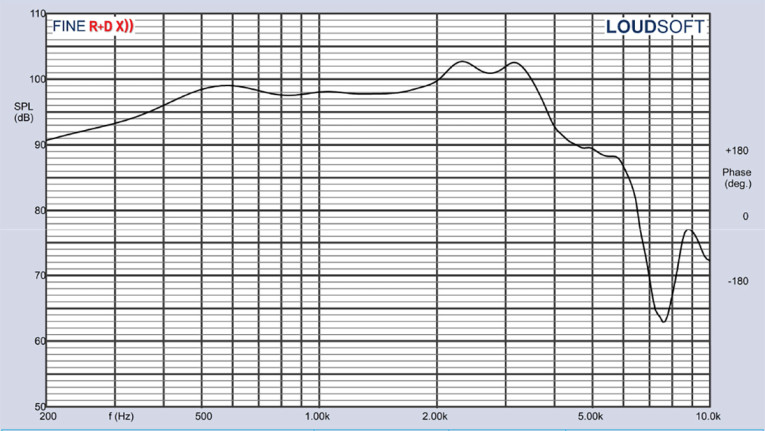
Figure 11 displays the on- and off-axis frequency response at 0°, 15°, 30°, and 45°, showing the typical directivity for a 10” woofer. The -3dB at 30 degrees with respect to the on-axis curve occurs at about 1.6 kHz, so a reasonable frequency (or lower) for a low-pass crossover. Figure 12 gives the normalized version of Figure 11.


Figure 13 shows the CLIO polar plot (in 10° increments and 1/3 octave smoothing. And finally, Figure 14 displays the two-sample SPL comparisons for the 10” B&C Speakers driver, showing a close match ≤1dB throughout the operating range up to 2kHz.

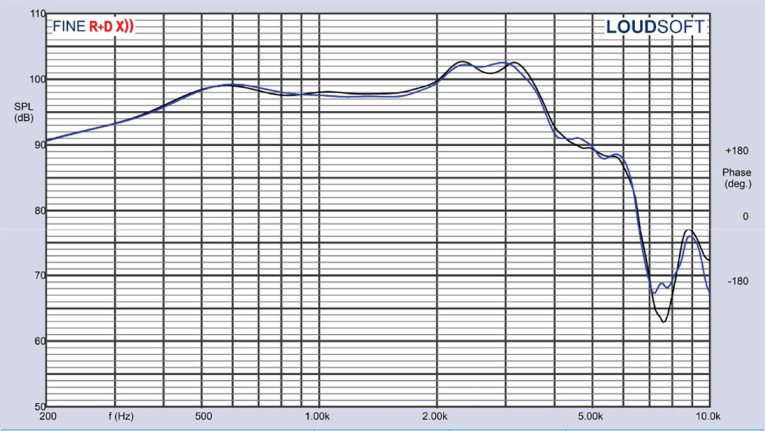
For the last remaining series of tests on the 10NW76, I again employed the Listen, Inc. SoundCheck AudioConnect analyzer and SCM ¼” microphone to measure distortion and generate time-frequency plots. For the distortion measurement, the 10” driver was mounted rigidly in free-air, and the SPL set to 104dB at 1m (6.9V), using a pink noise stimulus. Then, I measured the distortion with the Listen microphone placed 10cm from the driver. This produced the distortion curves shown in Figure 15, with third harmonic distortion staying below 0.75%.
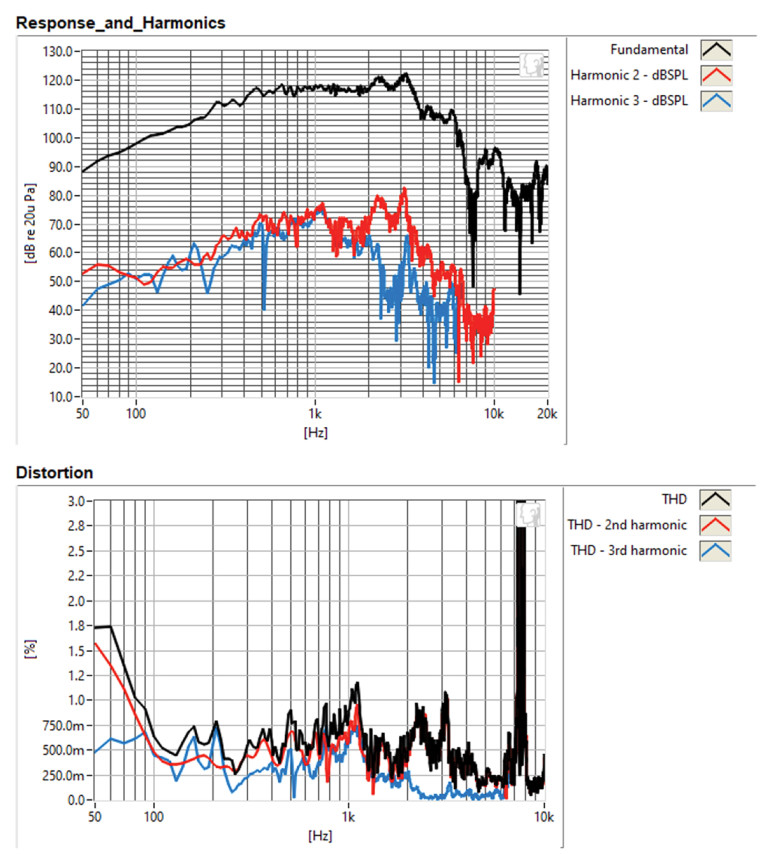
Next, I used SoundCheck to get a 2.83V/1m impulse response for this driver and imported the data into Listen’s SoundMap Time/Frequency software. Figure 16 shows the resulting CSD waterfall plot. Figure 17 provides the Wigner-Ville plot (chosen for its better low-frequency performance).


Given the data collected, and the consistently good performance exhibited by B&C Speakers’ woofers, the 10NW76 looks like an excellent to addition the company’s 10” woofer category. For more information, visit www.bcspeakers.com. VC
This article was originally published in Voice Coil, December 2021.





